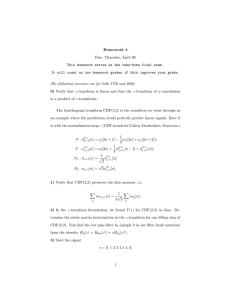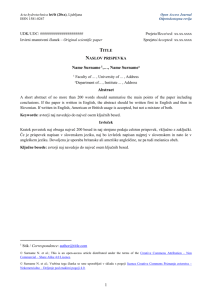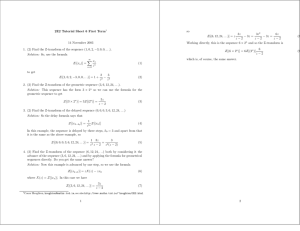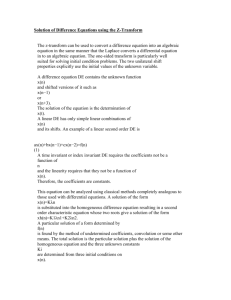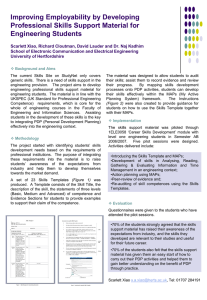Selected Solutions to Homework 4
advertisement
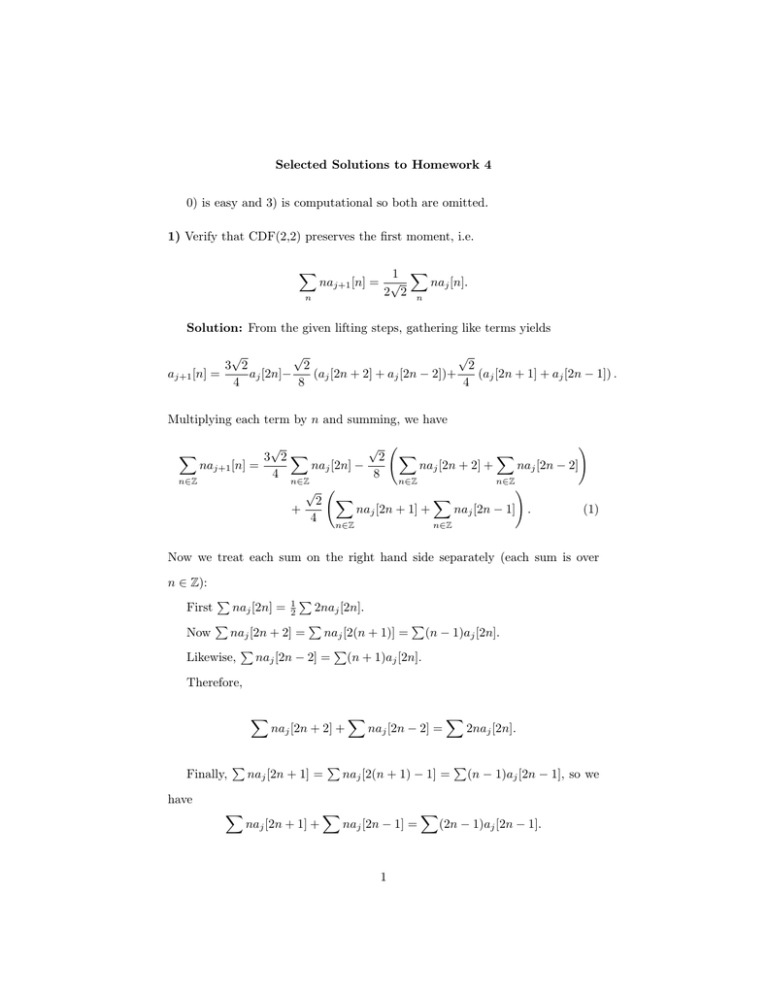
Selected Solutions to Homework 4
0) is easy and 3) is computational so both are omitted.
1) Verify that CDF(2,2) preserves the first moment, i.e.
X
n
1 X
naj+1 [n] = √
naj [n].
2 2 n
Solution: From the given lifting steps, gathering like terms yields
√
√
√
2
2
3 2
aj [2n]−
(aj [2n + 2] + aj [2n − 2])+
(aj [2n + 1] + aj [2n − 1]) .
aj+1 [n] =
4
8
4
Multiplying each term by n and summing, we have
!
√
√
X
3 2X
2 X
naj+1 [n] =
naj [2n] −
naj [2n + 2] +
naj [2n − 2]
4
8
n∈Z
n∈Z
n∈Z
n∈Z
!
√
X
2 X
naj [2n + 1] +
naj [2n − 1] .
(1)
+
4
X
n∈Z
n∈Z
Now we treat each sum on the right hand side separately (each sum is over
n ∈ Z):
P
1
2
P
2naj [2n].
P
P
Now
naj [2n + 2] = naj [2(n + 1)] = (n − 1)aj [2n].
P
P
Likewise,
naj [2n − 2] = (n + 1)aj [2n].
First
naj [2n] =
P
Therefore,
X
naj [2n + 2] +
P
naj [2n + 1] =
X
naj [2n + 1] +
Finally,
P
X
naj [2n − 2] =
X
naj [2(n + 1) − 1] =
2naj [2n].
P
(n − 1)aj [2n − 1], so we
have
X
naj [2n − 1] =
1
X
(2n − 1)aj [2n − 1].
Thus, using these identities, we can rewrite (1) as
X
n∈Z
√
√
√
3 2X
2X
2X
2naj [2n] −
2naj [2n] +
(2n − 1)aj [2n − 1]
8
8
4
n∈Z
n∈Z
n∈Z
!
√
X
2 X
2naj [2n] +
(2n − 1)aj [2n − 1]
=
4
naj+1 [n] =
n∈Z
n∈Z
1 X
= √
naj [n].
2 2 n∈Z
2) In the z-transform formulation, we found T (z) for CDF(2,2) in class. Determine the entire matrix factorization in the z-transform for one lifting step of
CDF(2,2). Now find the low pass filter h0 (simply h in our filter bank notation)
from the identity H0 (z) = H00 (z 2 ) + zH01 (z 2 ).
Solution: As in class, the easiest way to do this is to take the z-transform
of the given prediction and update steps. The z-transfrom of P is
1
(1)
Dj+1 (z) = Aj1 (z) − (1 + z)Aj0 (z).
2
The z-transform of the update step is
1
(1)
(1)
Aj+1 (z) = Aj0 (z) + (z −1 + 1)Dj+1 (z).
4
Thus, including the normalization, we have
√
Aj+1 (z) 2
=
Dj+1 (z)
0
0 1
√1
0
2
1 −1
4 (z
1
2
+ 1)
1
− 12 (1 + z)
Aj0 (z)
0
.
j
1
A1 (z)
Hence, H(z) is the product of the three 2 × 2 matrices, namely
−1
1 −(z − 6 + z)
H(z) = √
4 2
−2(1 + z)
2(z
−1
4
+ 1)
.
Using the identity H0 (z) = H00 (z 2 ) + zH01 (z 2 ), we have
1
H0 (z) = √ (−z −2 + 2z −1 + 6 + 2z − z 2 ).
4 2
Since H0 (z) is the z-transform of our low pass filter h0 , we have that
h0 [n] =
1
− 4√
2
1
√
n = ±2
n = ±1
2 2
3
√
2 2
0
n=0
n 6= 0, ±1, ±2.
Similarly, we can find the high pass filter, h1 ,
h1 [n] =
1
− 2√
2
√1
n = 0, 2
n=1
2
0
n 6= 0, 1, 2.
Since h0 has 5 nonzero coefficients and h1 has 3 nonzero coefficients, CDF(2,2)
is often called the 5\3-biorthogonal wavelet.
3
4) Suppose Lift(s) performs the lifting implementation for some transform on
a one dimensional signal, s = {s[n] : n ∈ Z}. Describe how to perform a two
dimensional, separable transform on an image, im = {im[n1 , n2 ] : n1 , n2 ∈ Z}.
(Pseudo code is appropriate if that is easier for you.)
Solution: Since many of you used MatLab, I’ll use the MatLab format.
The algorithm should check for errors, such as k not being too large and
that you want m and n to be powers of 2.
Algorithm 1 2d Lifting Implementation
Input:
The image: im
Number of levels of the transfrom: k
Output: An image transformed k levels
Initialization:
1:
2:
Set z = 0
[m, n] = size(im);
(initialize the counter)
(assign the dimensions of the image)
Iteration:
1: while z < k do
2:
for i = 1 : m do
3:
A(i, :) = Lift(im(i, :));
(perform the transform on the rows)
4:
end for
5:
for i = 1 : n do
6:
T (1 : m, i) = Lift(A(:, i)0 ); (transform the columns of the new matrix)
7:
end for
8:
im = [ ]; A = [ ]; m = m/2; n = n/2;
(reset the internal variables)
9:
im = T (1 : m, 1 : n);
(extract the low pass portion of the transformed
matrix for the next iteration)
10:
z = z + 1;
(update the counter)
11: end while
12: return T
4
G5) Determine the z-transform factorization of the form
K
H(z) =
0
0
K −1
m
Y
1
0
i=1
1
Si (z)
−Ti (z)
1
0
1
for the biorthogonal transfrom CDF(3,3).
Following the method from 2), we arrive at
H(z) =
√3
2
0
0 1
2
0
3
√
1
−1
36 (3z
1
+ 16 − 3z)
− 83 (3 + z)
1
0 1
1
0
5
− 13 z −1
1
.
